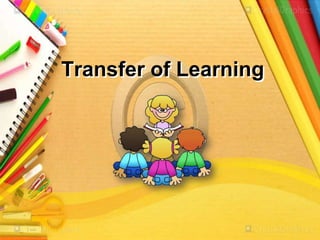
Transfer of Learning and Motivation in Learning
- 2. TRANSFER OF LEARNING • It implies a carrying over and application of the knowledge, skills, habits, ideals, attitudes or values acquired in one situation to another.
- 3. THEORIES OF TRANSFER OF LEARNING • The Theory of Mental Disciplines Based on the old faculty psychology which maintains that the various faculties of the mind can be developed through training and can become capable of effective performance in all areas in which they are involved. Thus the training of the faculty of memory for names, meaningful material and, in fact, for anything which calls for memory.
- 4. • THE THEORY OF IDENTICAL ELEMENTS This theory was formulated by Thorndike which maintains that the amount of transfer depends upon the identical elements or elements that are common in both situations. The identical elements, such as content, method, aim, or attitude present in both situations facilitate learning.
- 5. • Example: A study of Latin helps in interpreting many English words. Since many English words are derived from Latin, then the transfer is due to Identity of content. • THE THEORY OF GENERALIZATION The Theory formulated by Charles H. Judd, which maintains that transfer is a form of generalization which can be encouraged by training. It means that experiences obtained in one situation are applicable to other situations.
- 6. • It puts emphasis upon the value to understand, organize, and generalize specific experiences. There is a need for the learner to interpret relationships and to be able to recognize and apply to other situations the previously acquired facts or principles.
- 7. • THE THEORY OF CONFIGURATION This theory is based on the Gestalt theory of learning. It holds that the transfer of training from one situation to another is the result of the application of certain principles of configuration. It means that the transfer of acquired patterns of response to a new situation depends upon the insight of the learner into the total situation to enable him to use those patterns.
- 9. • Motivation is a process in which the individual’s attention and interest are aroused and directed toward definite goals. An individual’s attention and interest can be aroused to the extent that his needs, whether basic or acquired, are involved. • It is the job of the teacher to create an atmosphere which provides desirable outlets for needs in the direction of worthwhile incentives – an atmosphere in which interests will as a consequence flourish.
- 10. TYPES OF MOTIVATION IN LEARNING • 1. Intrinsic Motivation This type of motivation is an internal stimulus to learning. It is based on motives that every individual strives to satisfy. Motives are intrinsic, or within the person. They have their roots in needs and drives. Motive is a though, feeling, or condition that causes one to act. The most common forms of intrinsic motivation are the desire for knowledge, the desire to explore, and the desire to construct.
- 11. 2. Extrinsic Motivation This type of motivation is an external stimulus to learning activity. Praise and blame, rivalry, rewards and punishments are some of the more common types of extrinsic motivation. It is based on incentives. Incentive is the means employed to evoke attitude conducive to learning. In Extrinsic Motivation the pupil is encouraged to do good school work by such drives as marks, honors, prizes, scholarships, and privileges.
